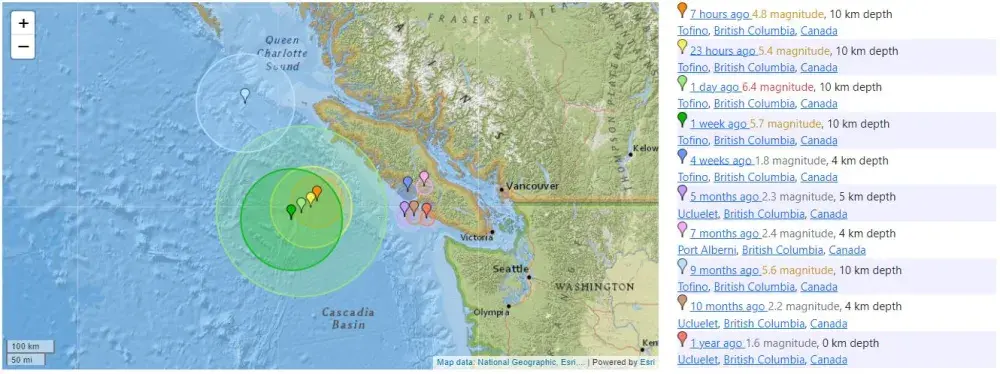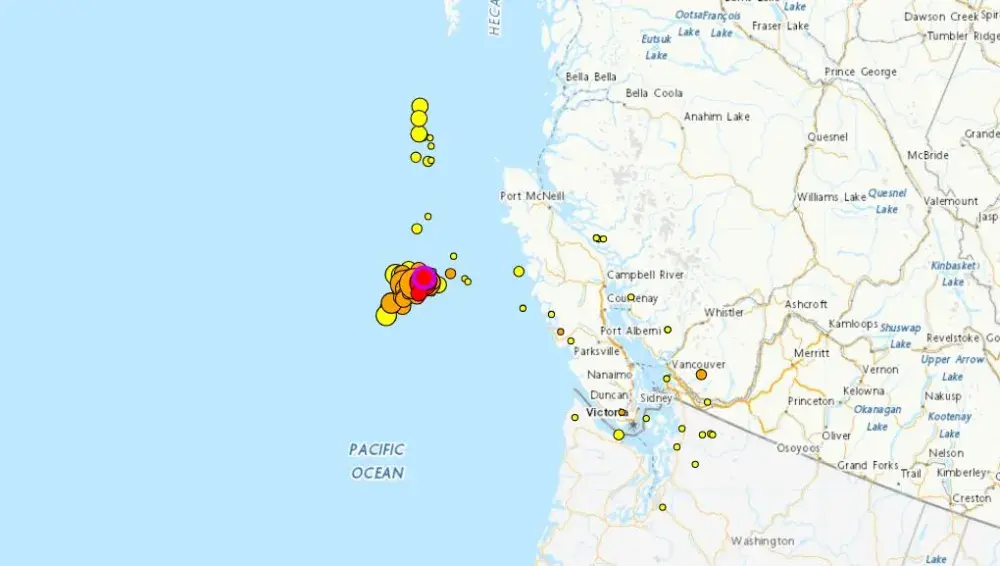In the early morning hours of July 11th Tofino residents felt the effects of an earthquake 209 kilometres off their coast. A magnitude 6.4 earthquake with a depth of 10 kilometres was measured and reported by the U.S. Geological Survey at 8:08 a.m., followed by another four quakes, magnitude 4.3, 4.9 4.8, and then the last 4.6 magnitude event at around 8:20am on July 12.
A magnitude of 6.4 earthquake could trigger smaller earthquakes. According to the U.S. Geological Survey, there is a 99 per cent chance of at least one aftershock of greater than magnitude 3 within the next week.
The magnitude 6.4 earthquake was “lightly felt” on Vancouver Island, with no damage or tsunami, reports Earthquakes Canada, and these five earthquakes bring the total to 14 in July. A preliminary magnitude of all around 4.0 or greater have now been detected from these seismic events in B.C. waters since the start of July.
Port Alberni Marine Fuels and Services staff reported seeing “a random series of small waves” pass by their fuel dock mid-afternoon on July 11.
“We are currently experiencing a swarm of activity offshore Vancouver Island, at the intersection of the Juan de Fuca Ridge, the Sovanco Fracture Zone, and the Nootka Fault,” stated Earthquakes Canada.
With all this recent earthquake activity, it has some Vancouver Island residents wondering if they could be feeling ‘the big one’ any time soon.
While coastal British Columbia experiences the largest and most frequent of Canadian earthquakes, including offshore events that may cause tsunamis, Earthquakes Canada says there is no indication a larger and more damaging one is expected in the coming months or even years. But it is important to be prepared.
After the reported earthquakes Tseshaht First Nation released a series of informational posters to help their community members know what to do and how to be prepared. The First Nation advises members to keep in mind that phone, gas, electricity and water may not work after a large seismic event. Roads may be blocked, and Tseshaht stresses the need to prepare a grab-and-go bag for each member of a home, including pets. Each bag should be personalized to the person’s needs, but things like first aid kits, garbage bags, sanitary items, drinking water, nonperishable food with a manual can opener, flashlight, batteries, phone charger and a whistler to signal for help are always good to have in case of an emergency.
Duriing an earthquake event once you feel the ground shake or hear an alert you must immediately drop, cover and hold on until the shaking ends, but anticipate more aftershocks as well, states the First Nation. After it is safe to move, assess your situation and be aware there may be other hazards caused by the earthquake such as fires or a tsunami.
In case of a tsunami, coastal residents are urged to listen to the local radio, tv, outdoor sirens or wireless emergency alerts and then proceed to a local muster area, higher ground or inland.
More information on emergency preparedness is available at www.getprepared.gc.ca. For more on Canadian earthquakes, you can visit www.earthquakescanada.nrcan.gc.ca








